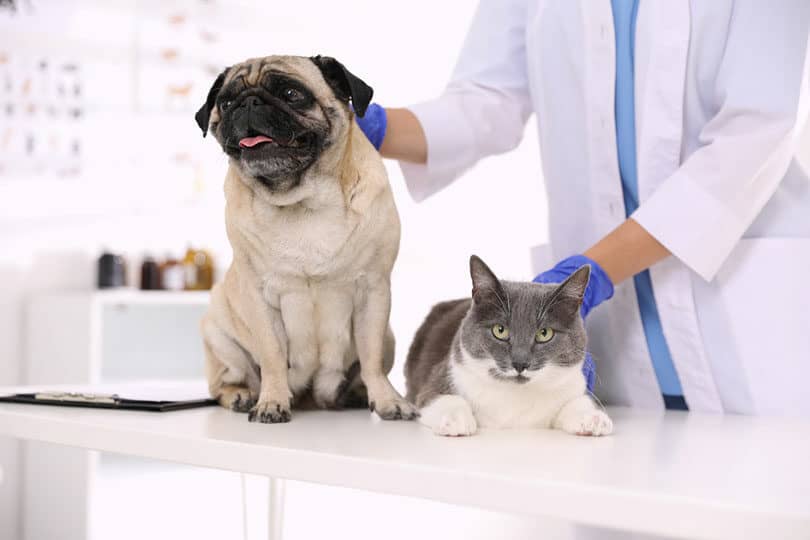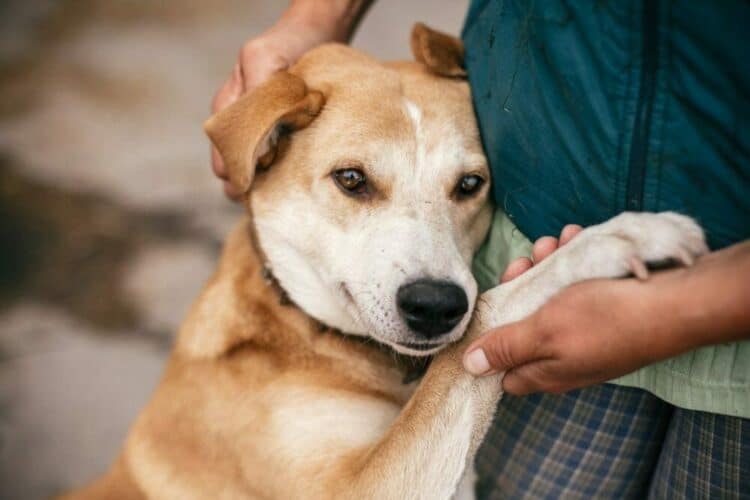Note: This article’s statistics come from third-party sources and do not represent the opinions of this website.
When a pet falls ill, it is incredibly distressing and the treatment costs can be a substantial financial strain. The cost of pharmaceutical products is on the rise, and, as a result, so are vet fees. For this reason, some pet parents decide to invest in a pet insurance plan to help ease the potential burden.
Research shows that Australians are major pet lovers, making Australia one of the countries with the highest rates of pet ownership in the world, but how many Australians actually have a pet insurance plan? In this post, we’ll share the stats on pet insurance and pet ownership in Australia to see how it all links up and what conclusions we can make about pet insurance trends.
How Many Australian Pet Owners Have Pet Insurance – The 12 Statistics
- A survey showed that 40.7% of Australians with vet bills up to $10,000 had a pet insurance plan.
- 73% of those with insurance were reimbursed more than 50%.
- 66% of Australians without pet insurance feel that pet insurance is too expensive.
- As of February 2022, 15% of pet owners took their pet to the vet at least once.
- A 2019 pet ownership survey showed that $744.5 million was spent nationally on pet insurance.
- A 2018 study by Roy Morgan showed that employed people make up 4% of pet insurance holders.
- Pet Insurance Australia has insured over 100,000 dogs and cats since the year 2010.
- There are almost 29 million pets in Australia.
- Dogs are the most common pet in Australia (40%).
- A 2019 survey showed that almost two-thirds of Australian households have a pet.
- The RSPCA receives approximately 55,000–60,000 animal mistreatment reports every year.
- Australians are estimated to have spent $13 billion on pet care and products in 2019.
Pet Insurance in Australia
1. A 2021 survey showed that 40.7% of Australians with vet bills up to $10,000 had a pet insurance plan.
(Budget Direct)

The results show that around 60% of Australians with vet bills up to $10,000 do not have a pet insurance plan in place, leaving 40.7% that do. The same survey showed that approximately 50% of those who responded said they would be happy to pay the $10,000 to save their oldest/only pet’s life.
2. 73% of those with insurance were reimbursed more than 50%.
(Budget Direct)
The survey conducted by Budget Direct revealed that around 73% of those with pet insurance were reimbursed at least 50% and up to 80%.
3. 66% of Australians without pet insurance feel that pet insurance is too expensive.
(Budget Direct)

The cost of pet insurance appears to be a major factor in some pet owners choosing not to have a pet insurance plan. Of those surveyed, a larger proportion of younger respondents felt this way. However, it was mostly younger respondents who reported that they would pay $10,000 if it meant saving their pet’s life.
4. As of February 2022, 15% of pet owners took their pet to the vet at least once.
(Statista)
23% of those surveyed stated that they had not taken their pet to a vet in the last 12 months. 2% had taken their pet to a vet at least five times.
5. A 2019 pet ownership survey showed that $744.5 million was spent nationally on pet insurance.
(Animal Medicines Australia)
The data covered dogs and cats and revealed that the cost of pet insurance rose by 56% in 3 years.
6. A 2018 study by Roy Morgan showed that employed people make up 77.4% of pet insurance holders.
(Roy Morgan)
The findings by Roy Morgan showed that in 2018, more than 600,000 pet owners had a pet insurance plan. Of those, 77.4% were employed. Women made up 59.8% of this number.
7. Pet Insurance Australia has insured over 100,000 dogs and cats since the year 2010.
(Pet Insurance Australia)

Award-winning pet insurance provider Pet Insurance Australia has insured more than 100,000 pets since 2010. The provider has won the Mozo Exceptional Value award on multiple occasions as well as the Canstar Outstand Value Pet Insurance award.
Pet Ownership in Australia
8. There are almost 29 million pets in Australia.
(Animal Medicines Australia)
According to the survey, approximately 5.1 million of these pets are dogs and 3.8 million are cats. There are also an estimated 11.3 million fish, 5.6 million birds, 614,000 small mammals, and 1.8 million pets categorized as “other”.
9. Dogs are the most common pet in Australia (40%)
(RSPCA Pet Insurance)

According to RSPCA Pet Insurance, dogs make up 40% of Australian pets and cats make up 27%.
10. A 2019 survey showed that almost two-thirds of Australian households have a pet.
(Animal Medicines Australia)
These results show what huge animal lovers Australians are. The results also showed that 90% of Australians have had a pet at some point in their lives.
Pet Care and Costs in Australia
11. The RSPCA receives approximately 55,000–60,000 animal mistreatment reports every year.
(NIH – National Library of Medicine)

Sadly, it appears that a huge number of animals are subject to mistreatment, cruelty, and neglect in Australia, with more than 55,000 incidences being reported to the RSPCA every year. Neglect includes the failure to seek veterinary attention for an animal in need.
12. Australians are estimated to have spent $13 billion on pet care and products in 2019.
(RSPCA)
The money went on food, healthcare products, general products and accessories, and veterinary services. 30% was spent on “other”, uncategorized products and services.
Frequently Asked Questions About Pet Insurance
What Types of Pet Insurance Plans Are There?
The most standard pet insurance plan is accident and illness coverage. Conditions covered in these plans are laid out in each insurance provider’s individual policies, so it’s highly recommended to check these carefully.
Examples of conditions or situations typically covered by accident and illness coverage plans include car accidents, snake bites, a variety of skin conditions, eye and ear conditions and gastrointestinal conditions, cancer, and surgery. These plans do not typically cover routine care like vaccinations.
Pre-existing conditions are not typically covered, though some providers do allow for temporary pre-existing conditions. To reiterate, what’s covered may differ depending on your provider and the plan you choose.
Some pet insurance providers also offer wellness plans for routine care as an add-on or standalone plan.

Does Pet Insurance Cover Routine Care like Microchipping and Vaccinations?
Comprehensive accident and illness insurance plans typically do not cover routine care like microchipping, vaccinations, deworming, and annual vet checkups. However, many insurance providers offer wellness or routine care plans that do cover these things.
How Much Does Pet Insurance Cost?
This varies depending on the type of pet you have and is based on factors like breed, age, and medical history. According to Money Smart, pet insurance typically costs between $20 and $60 per month in Australia. It’s usually more expensive to insure a dog than a cat.

What Is a Waiting Period?
A waiting period is the length of time between when your pet insurance policy starts and the time the policy actually takes effect and you can claim the benefits.
Can I Still Go to My Regular Vet?
It seems so. According to the RSPCA’s pet insurance policy, you can visit any registered vet in Australia that you like. Please check your pet insurance provider’s individual policy on this just to be sure.

Is It Worth It to Get Pet Insurance?
This depends on whether or not you feel you’ll be able to comfortably afford potential vet bills down the line. Paying for insurance over the course of your pet’s life can be costly—there are no two ways about it—but for some, the peace of mind is worth it.
Even if your pet seems happy and healthy, it’s impossible to predict what may happen down the line, so pet insurance is a sort of “cushion”, if you will, for unexpected and sudden illnesses, accidents, and ongoing treatments. For this reason, pet insurance definitely worth at least considering.
What Do I Do If I Can’t Afford Vet Fees?
If you don’t have pet insurance and can’t cover vet bills, please let your vet know about your situation and they may be able to work out a payment plan for you, like paying in installments. Some vets do accommodate this kind of request.
In Australia, there’s a service called VetPay, which is designed to help people pay for veterinary treatments over a period of time rather than all in one go.
You could also try getting a second opinion from a different vet who may be able to treat your pet at a lower price or come up with an alternative treatment plan.
Final Thoughts
To recap, according to a survey of pet owners in Australia with vet bills, around 40% had insurance and 60% did not. Research from 2018 revealed that over 600,000 pet owners in Australia have pet insurance.
When you consider how many Australians have a pet in their household—two-thirds of households, to be precise—the number of people with pet insurance seems quite low. The cost of pet insurance appears to be a major factor in why some pet owners choose not to invest in a plan, and studies have shown that females are more likely to get pet insurance than males.
We also noticed that age was an influencing factor, with more young people responding that they would pay large sums of money upfront for lifesaving treatment.
To conclude, if you’re considering getting pet insurance, we recommend checking out a few different providers to see what they offer. Plans are varied to suit a variety of budgets, so it’s certainly worth chatting with a company representative to find out which kind of plan would work best for you.
- See Also: What Is the Cost of a Dog in Australia?
Featured Image Credit: Bogdan Sonjachnyj, Shutterstock














